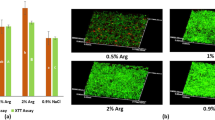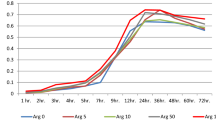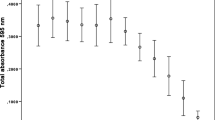Abstract
Dental plaque is a complex community of bacteria coexisting in an environment frequently limited by carbon and energy sources. UnlikeStreptococcus mutans, other oral streptococci such asS. milleri andS. sanguis have an absolute requirement for and actually consume all available arginine when grown glucose limited in a chemically defined medium. The conditions, particularly in terms of arginine concentration, under which the dental plaque bacteriaS. mutans andS. milleri would coexist under glucose-limiting conditions were investigated. The minimum level of arginine supporting optimal growth ofS. milleri was found to be ca. 50μM, and above this level these strains outcompetedS. mutans. However, coexistence withS. mutans could be achieved at arginine levels of 14–40μM, depending upon theS. milleri andS. mutans strains used. Under such dual limitation,S. milleri was unable to respond to glucose pulses but did respond to pulses of arginine and arginine plus glucose. One of the twoS. milleri strains did not tolerate low pH. In contrast,S. mutans did not tolerate high pH whereasS. milleri was unaffected. This is relevant to dental plaque where arginine catabolism produces a pH rise. Additionally, arginine is an important nutrient since it can be used as an energy source by some oral streptococci.
Similar content being viewed by others
References
Carlsson J (1972) Nutritional requirements ofStreptococcus sanguis. Arch Oral Biol 17:1327–1332
Crow VL, Thomas TD (1982) Arginine metabolism in lactic streptococci. J Bacteriol 150:1024–1032
Curtis MA, Eastoe JE (1978) Comparison of free amino acid pools in dental plaque fluid from monkeys (Macaco fascicularis) fed on high and low sugar diets. Arch Oral Biol 23:989–992
de Jong MH, van der Hoeven JS, van Os JH, Olivje JH (1984) The growth of oralStreptococcus spp andActinomyces viscosus in human saliva. Appl Environ Microbiol 47:901–904
Ellwood DC, Hunter JR (1976) The mouth as a chemostat. In: Dean ACR, Ellwood DC, Evans GCT, Melling J (eds) Continuous culture 6: applications and new fields. Ellis Horwood, Chichester, UK, pp 270–282
Gottschal JC, Thingstad TF (1982) Mathematical description of competition between two and three bacterial species under dual substate limitation in the chemostat: a comparison with experimental data. Biotechnol Bioeng 24:1403–1418
Harder W, Dijkhuizen L (1982) Strategies of mixed substrate utilization in microorganisms. Phil Trans R Soc Lond B 297:459–480
Harper DS, Loesche WJ (1984) Growth and acid tolerance of human dental plaque bacteria. Arch Oral Biol 29:843–848
Kanapka JA, Kleinberg I (1983) Catabolism of arginine by the mixed bacteria in human salivary sediment under conditions of low and high glucose concentration. Arch Oral Biol 28:1007–1015
Kemp CW, Robrish SA, Curtis MA, Shaver SA, Bowen WH (1983) Application of a competitive model to the growth ofStreptococcus mutans andStreptococcus sanguis in binary continuous culture. Appl Environ Microbiol 45:1277–1282
Kuenen JG, Gottschal JC (1982) Competition among chemolithotrophs and methylotrophs and their interactions with heterotrophic bacteria. In: Bull AT, Slater JH (eds) Microbial interactions and communities, Vol 1. Academic Press, London, pp 153–187
Marsh PD, Hunter JR, Bowden GH, Hamilton IR, McKee AS, Hardie JM, Ellwood DC (1983) The influences of growth rate and nutrient limitation on the microbial composition and biochemical properties of a mixed culture of oral bacteria grown in a chemostat. J Gen Microbiol 129:755–770
Rogers AH (1976) Bacteriocin patterns of strains belonging to various serotypes ofStreptococcus mutans. Arch Oral Biol 21:243–249
Rogers AH, de Jong MH, Zilm PS, van der Hoeven JS (1986) Estimation of growth parameters for some oral bacteria grown in continuous culture under glucose-limiting conditions. Infect Immun 52:897–901
Rogers AH, Zilm PS, Gully NJ (1986) The utilisation of arginine by oral streptococci grown glucose-limited in a chemostat. FEMS Microbiol Letts 37:9–13
Singer DL, Leinberg I (1983) The free amino acids in human dental plaque. Arch Oral Biol 28:873–878
Singer DL, Chatterjee R, Denepitiya L, Kleinberg I (1983) A comparison of the acid-base metabolisms of pooled human plaque and salivary sediment. Arch Oral Biol 28:29–35
Taylor PA, Williams PJ LeB (1975) The critical studies on the coexistence of competing species under controlled flow conditions. Can J Microbiol 21:90–98
van der Hoeven, JS, de Jong MH, Rogers AH, Camp PJM (1984) A conceptual model for the co-existence ofStreptococcus spp andActinomyces spp in dental plaque. J Dent Res 63:389–392
van der Hoeven JS, de Jong MH, Rogers AH (1985) Effect of utilization of substrates on the composition of dental plaque. FEMS Microbiol Ecol 31:129–131
van der Hoeven JS, de Jong MH, Camp PJM, van der Kieboom CWA (1985) Competition between oralStreptococcus species in the chemostat under alternating conditions of glucose limitation and excess. FEMS Microbiol Ecol 31:373–379
Veldkamp H (1977) Ecological studies with the chemostat. Adv Microbial Ecol 1:59–94
Veldkamp H, van Gemerden H, Harder W, Laanbroek, HJ (1984) Competition among bacteria: an overview. In: Klug MJ, Reddy CA (eds) Proc 3rd Int Symp on Microbial Ecology, Am Soc Microbiol, Washington, DC, pp 279–290
Author information
Authors and Affiliations
Rights and permissions
About this article
Cite this article
Rogers, A.H., Zilm, P.S. & Gully, N.J. Influence of arginine on the coexistence ofStreptococcus mutans andS. milleri in glucose-limited mixed continuous culture. Microb Ecol 14, 193–202 (1987). https://doi.org/10.1007/BF02012940
Issue Date:
DOI: https://doi.org/10.1007/BF02012940




